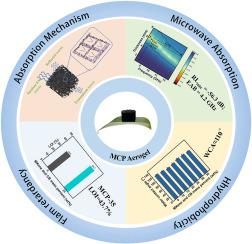MXene/ carbon black /polyimide aerogels: Integrating microwave absorption, thermal stability, flame retardancy, and hydrophobicity
IF 11.6
2区 材料科学
Q1 CHEMISTRY, PHYSICAL
引用次数: 0
Abstract
The electromagnetic absorption properties of single optimized wave-absorbing materials limit their practical applications in complex environments such as aerospace and military protection. Therefore, it is of great significance to develop composite materials that combine high temperature resistance, flame retardancy and other properties with efficient wave-absorbing properties. In this study, MXene/CB/PI (MCP) aerogels were successfully prepared by using polyimide (PI) as the polymer matrix and carbon black (CB) and MXene as the conductive fillers. The porous structure of the aerogel enhances the multiple reflections and propagation path length of electromagnetic waves. The conductive network facilitates the conversion of electromagnetic waves into electric currents for efficient conductive loss and multiple heterogeneous interfaces enhance the interfacial polarization. Therefore, the prepared MCP aerogel has excellent microwave absorption properties, with a minimum reflection loss (RLmin) of −56.3 dB and an effective absorption bandwidth (EAB) that completely covers the X-band (4.2 GHz). In addition, MCP aerogel also exhibits: excellent thermal stability (Weight loss is only noticeable above 520 °C), good flame retardancy (LOI up to 43.7 %) and good hydrophobicity (water contact angle of about 110°). MCP aerogel materials combine multiple functions and are expected to play an important role in aerospace and other fields.

MXene/炭黑/聚酰亚胺气凝胶:集微波吸收、热稳定性、阻燃性和疏水性于一体
单一优化吸波材料的电磁吸收性能限制了其在航空航天和军事防护等复杂环境中的实际应用。因此,开发将耐高温、阻燃等性能与高效吸波性能相结合的复合材料具有重要意义。以聚酰亚胺(PI)为聚合物基体,炭黑(CB)和MXene为导电填料,成功制备了MXene/CB/PI (MCP)气凝胶。气凝胶的多孔结构增强了电磁波的多次反射和传播路径长度。导电网络有利于电磁波转化为电流,实现高效的导电损耗,多个非均质界面增强了界面极化。因此,制备的MCP气凝胶具有优异的微波吸收性能,最小反射损耗(RLmin)为- 56.3 dB,有效吸收带宽(EAB)完全覆盖x波段(4.2 GHz)。此外,MCP气凝胶还表现出优异的热稳定性(在520℃以上失重明显)、良好的阻燃性(LOI高达43.7%)和良好的疏水性(水接触角约110°)。MCP气凝胶材料集多种功能于一体,有望在航空航天等领域发挥重要作用。
本文章由计算机程序翻译,如有差异,请以英文原文为准。
求助全文
约1分钟内获得全文
求助全文
来源期刊

Carbon
工程技术-材料科学:综合
CiteScore
20.80
自引率
7.30%
发文量
0
审稿时长
23 days
期刊介绍:
The journal Carbon is an international multidisciplinary forum for communicating scientific advances in the field of carbon materials. It reports new findings related to the formation, structure, properties, behaviors, and technological applications of carbons. Carbons are a broad class of ordered or disordered solid phases composed primarily of elemental carbon, including but not limited to carbon black, carbon fibers and filaments, carbon nanotubes, diamond and diamond-like carbon, fullerenes, glassy carbon, graphite, graphene, graphene-oxide, porous carbons, pyrolytic carbon, and other sp2 and non-sp2 hybridized carbon systems. Carbon is the companion title to the open access journal Carbon Trends. Relevant application areas for carbon materials include biology and medicine, catalysis, electronic, optoelectronic, spintronic, high-frequency, and photonic devices, energy storage and conversion systems, environmental applications and water treatment, smart materials and systems, and structural and thermal applications.
 求助内容:
求助内容: 应助结果提醒方式:
应助结果提醒方式:


